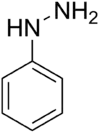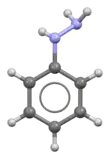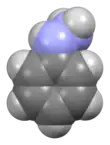Phenylhydrazine
Phenylhydrazine is the chemical compound with the formula C6H5NHNH2. It is often abbreviated as PhNHNH2. It is also found in edible mushrooms.[5]
 | |||
| |||
| Names | |||
|---|---|---|---|
| Preferred IUPAC name
Phenylhydrazine | |||
| Other names
Hydrazinobenzene | |||
| Identifiers | |||
3D model (JSmol) |
|||
| ChEBI | |||
| ChEMBL | |||
| ChemSpider | |||
| ECHA InfoCard | 100.002.612 | ||
| KEGG | |||
PubChem CID |
|||
| UNII | |||
CompTox Dashboard (EPA) |
|||
| |||
| |||
| Properties | |||
| C6H5NHNH2 | |||
| Molar mass | 108.144 g·mol−1 | ||
| Appearance | Colorless to pale-yellow liquid or solid[3] | ||
| Odor | faint, aromatic[3] | ||
| Density | 1.0978 g/cm3 | ||
| Melting point | 19.5 °C (67.1 °F; 292.6 K) (24 °C for hemihydrate) | ||
| Boiling point | 243.5 °C (470.3 °F; 516.6 K) (decomposition) | ||
| Vapor pressure | 0.04 mmHg (25°C)[3] | ||
| -67.82·10−6 cm3/mol | |||
| Hazards | |||
| NFPA 704 (fire diamond) | |||
| Flash point | 88 °C; 190 °F; 361 K[3] | ||
| Lethal dose or concentration (LD, LC): | |||
LD50 (median dose) |
| ||
| NIOSH (US health exposure limits): | |||
PEL (Permissible) |
TWA 5 ppm (22 mg/m3) [skin][3] | ||
REL (Recommended) |
Ca C 0.14 ppm (0.6 mg/m3) [2-hr] [skin][3] | ||
IDLH (Immediate danger) |
Ca [15 ppm][3] | ||
Except where otherwise noted, data are given for materials in their standard state (at 25 °C [77 °F], 100 kPa).
Infobox references | |||
Properties
Phenylhydrazine forms monoclinic prisms that melt to an oil around room temperature which may turn yellow to dark red upon exposure to air.[1] Phenylhydrazine is miscible with ethanol, diethyl ether, chloroform and benzene. It is sparingly soluble in water.
Preparation
Phenylhydrazine is prepared by oxidizing aniline with sodium nitrite in the presence of hydrogen chloride to form the diazonium salt, which is subsequently reduced using sodium sulfite in the presence of sodium hydroxide to form the final product.[6]
History
Phenylhydrazine was the first hydrazine derivative characterized, reported by Hermann Emil Fischer in 1875.[7][8] He prepared it by reduction of a phenyl diazonium salt using sulfite salts. Fischer used phenylhydrazine to characterize sugars via formation of hydrazones known as osazones with the sugar aldehyde. He also demonstrated in this first paper many of the key properties recognized for hydrazines.
Uses
Phenylhydrazine is used to prepare indoles by the Fischer indole synthesis, which are intermediates in the synthesis of various dyes and pharmaceuticals.
Phenylhydrazine is used to form phenylhydrazones of natural mixtures of simple sugars in order to render the differing sugars easily separable from each other.[9]
This molecule is also used to induce acute hemolytic anemia in animal models.
Safety
Exposure to phenylhydrazine may cause contact dermatitis, hemolytic anemia, and liver damage.[1]
References
- Merck Index, 11th Edition, 7264.
- Pure component properties
- NIOSH Pocket Guide to Chemical Hazards. "#0499". National Institute for Occupational Safety and Health (NIOSH).
- "Phenylhydrazine". Immediately Dangerous to Life or Health Concentrations (IDLH). National Institute for Occupational Safety and Health (NIOSH).
- Phenylhydrazines in the cultivated mushroom (Agaricus bisporus). 2004. ISBN 9789289301978.
- Merck Index of Chemicals and Drugs, 9th ed. monograph 7098
- Nobel Committee Emil Fischer - Biographical
- Fischer, E. (1875) "Ueber aromatische Hydrazinverbindungen," Berichte der deutschen chemischen Gesellschaft, 8: 589-594.
- Andrew Streitwieser; Clayton Heathcock (1976). Introduction to Organic Chemistry. Macmillan. ISBN 0-02-418010-6.
External links
- Phenylhydrazines at the U.S. National Library of Medicine Medical Subject Headings (MeSH)
- PubChem
- Additional chemical properties of phenylhydrazine
- CDC - NIOSH Pocket Guide to Chemical Hazards


